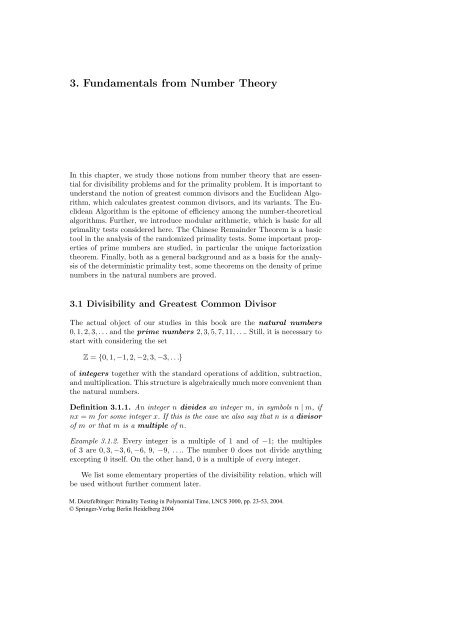Dietzfelbinger M. Primality testing in polynomial time ... - tiera.ru
Dietzfelbinger M. Primality testing in polynomial time ... - tiera.ru
Dietzfelbinger M. Primality testing in polynomial time ... - tiera.ru
Create successful ePaper yourself
Turn your PDF publications into a flip-book with our unique Google optimized e-Paper software.
3. Fundamentals from Number Theory<br />
In this chapter, we study those notions from number theory that are essential<br />
for divisibility problems and for the primality problem. It is important to<br />
understand the notion of greatest common divisors and the Euclidean Algorithm,<br />
which calculates greatest common divisors, and its variants. The Euclidean<br />
Algorithm is the epitome of efficiency among the number-theoretical<br />
algorithms. Further, we <strong>in</strong>troduce modular arithmetic, which is basic for all<br />
primality tests considered here. The Ch<strong>in</strong>ese Rema<strong>in</strong>der Theorem is a basic<br />
tool <strong>in</strong> the analysis of the randomized primality tests. Some important properties<br />
of prime numbers are studied, <strong>in</strong> particular the unique factorization<br />
theorem. F<strong>in</strong>ally, both as a general background and as a basis for the analysis<br />
of the determ<strong>in</strong>istic primality test, some theorems on the density of prime<br />
numbers <strong>in</strong> the natural numbers are proved.<br />
3.1 Divisibility and Greatest Common Divisor<br />
The actual object of our studies <strong>in</strong> this book are the natural numbers<br />
0, 1, 2, 3,...and the prime numbers 2, 3, 5, 7, 11,.... Still, it is necessary to<br />
start with consider<strong>in</strong>g the set<br />
Z = {0, 1, −1, 2, −2, 3, −3,...}<br />
of <strong>in</strong>tegers together with the standard operations of addition, subtraction,<br />
and multiplication. This st<strong>ru</strong>cture is algebraically much more convenient than<br />
the natural numbers.<br />
Def<strong>in</strong>ition 3.1.1. An <strong>in</strong>teger n divides an <strong>in</strong>teger m, <strong>in</strong>symbolsn | m, if<br />
nx = m for some <strong>in</strong>teger x. If this is the case we also say that n is a divisor<br />
of m or that m is a multiple of n.<br />
Example 3.1.2. Every <strong>in</strong>teger is a multiple of 1 and of −1; the multiples<br />
of 3 are 0, 3, −3, 6, −6, 9, −9, .... The number 0 does not divide anyth<strong>in</strong>g<br />
except<strong>in</strong>g 0 itself. On the other hand, 0 is a multiple of every <strong>in</strong>teger.<br />
We list some elementary properties of the divisibility relation, which will<br />
be used without further comment later.<br />
M. <strong>Dietzfelb<strong>in</strong>ger</strong>: <strong>Primality</strong> Test<strong>in</strong>g <strong>in</strong> Polynomial Time, LNCS 3000, pp. 23-53, 2004.<br />
© Spr<strong>in</strong>ger-Verlag Berl<strong>in</strong> Heidelberg 2004












